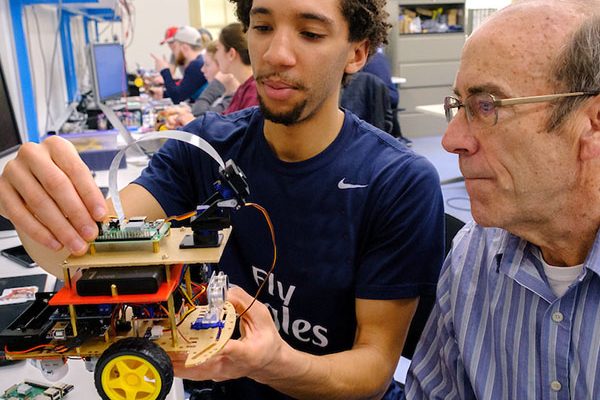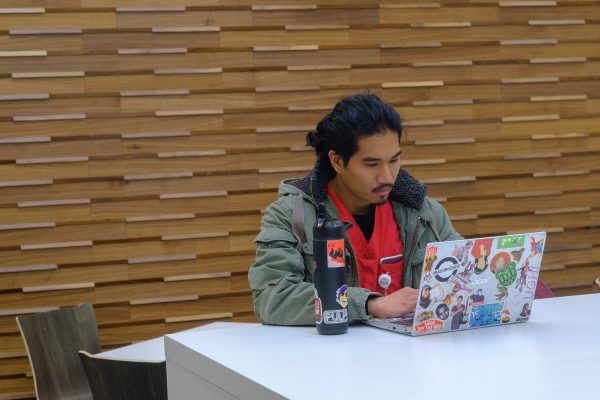By Robyn Brown, Interim Director of Miami Regionals E-Campus & E-Campus Faculty Engagement Coordinator
What should you expect when you take an online class? Robyn Brown, E-Campus Faculty Engagement Coordinator, outlines some key differences – and similarities – between online and face-to-face courses – for both students and instructors.
Difference #1: You’re (usually) not all going to sit in a room together and work at the same time
Unlike their face-to-face counterparts on campus, online courses are predominantly asynchronous: students and faculty each determine when and where they will engage and participate in their online courses. Asynchronous courses present an advantage to non-traditional students, like parents and working professionals, who need a flexible schedule in order to pursue their education. Additionally, asynchronous courses are also advantageous to students who learn best when they can review course lectures and materials multiple times and through a variety of exercises.
Difference #2: Successful online learners must be motivated, disciplined, self-directed, and good at time management without instructor facetime.
Successful students in face-to-face courses must actively listen and participate in class, take good notes, study, and complete coursework. Showing up to class goes a long way to successful completion. In the online environment, without an instructor standing before you telling you exactly everything you need to know to pass the next test or ace an upcoming writing assignment, successful online learners must also be motivated, disciplined, self-directed, and good at time management.
Difference #3: Diverse communication skills are paramount in online learning
In online courses, many learning exercises and course materials involve diverse communication skills: students will read written content, watch and listen to videos and audio, and interact with others in a variety of communication styles. Diverse communication skills are paramount in online learning. While different from its face-to-face counterpart, which involves more lecture- and dialogue-based learning exercises, the advantage of having diversely-communicated course content is that students may read or view and review the course materials over and over again (as many times as needed). Online students can use this to their advantage.
Difference #4: Students depend even more on the facilitation, assignment clarification, and feedback provided by their instructor
In a face-to-face course, students can plan on getting information and feedback about their learning and performance whenever they attend class. In asynchronous online courses without the live in-person class component, students depend even more on the facilitation, assignment clarification, and feedback provided by their instructor. It is even more important that students stay on top of this communication from their instructors on their own time.
Difference #5: Non-verbal, asynchronous correspondence makes up the majority of student-to-instructor and student-to-student communication
In online learning, the vast majority of communication from student-to-instructor and student-to-student involves non-verbal asynchronous correspondence – largely in the form of email, instant messages, video and audio messages, discussion forums, and reflections. While different from a face-to-face course, which also involves more in-person dialogue and conversations, an advantage of an online course is that instructors can generally communicate more ideas as well as clear, comprehensive messaging given that students may view, reread and review again and again. In a face-to-face course, students may have only heard the information that one time it was said during class.
Difference #6: Digital literacy and netiquette are musts
Digital literacy and netiquette are musts – for instructors and for students. You do not need to be proficient at computer programming languages and writing code to teach or take an online course. But, you do need to be comfortable working within a learning management system and basic computing programs such as email, Google apps and publisher software (such as Word), as well as comfortable with using resources to troubleshoot basic technical difficulties. Netiquette is also vital to ensure that you are able to communicate and build relationships with others in a productive manner without face-to-face interaction. While you don’t have to be a computer wiz, you should have a positive attitude and an open mind about learning new things and interacting with others in the digital world.
Difference #7: Discussions in the online environment may offer more opportunities for students to think about, research, and even draft their discussion posts and responses
Rich and complex student-driven class discussions may be facilitated in both environments, but with distinctly different advantages and disadvantages. Because they are asynchronous and often occur over longer periods of time (even days), discussions in the online environment may offer more opportunity for students to think about, research and even draft their discussion posts and responses. Furthermore, in the online environment, extroverted and introverted students stand on equal footing, which may result in more even, open, and honest discussions.
Difference #8: Online courses are often more personal and individualized
Without synchronized meeting times and places for the whole class like in face-to-face courses, student engagement in learning in an online course may feel, or even actually be, more personal and individualized than in a face-to-face setting. In online courses, teacher-led lectures and in-class exercises are replaced with student-directed learning options that are universally designed for all learners. Generally, instructors interact with students more frequently on an individual and personal basis, facilitating the learning of each student throughout the course. And, student-student interactions are generally more abundant.
Difference #9: Online learning more readily brings together diverse people, cultures, communities, and cities
Comprised of students logging in from all over the nation, online courses readily bring together diverse people, cultures, communities, and cities that expand our learning opportunities based on unique experiences and perspectives outside of our physical location.
Difference #10: Multi-dimensional content and learning exercises
When every aspect of learning and engagement in a class takes place in the online environment, it is very easy to infuse lots of multi-dimensional content and learning exercises throughout the course, including numerous technology-based learning opportunities. This is different than a traditional face-to-face course, which may rely more heavily on traditional lecture-style delivery of content and classroom-based learning exercises. Your online class may have interactive lessons, hands-on activities, and even gamified learning integrated into your coursework.
Difference #11: Active and frequent participation from everyone is required
Success in the online environment requires active and frequent participation from everyone. For instructors, writing lesson plans is replaced with preparing instructor presence plans and facilitating learning for students as they each work their way through the course. For students, showing up for class is replaced with scheduling time to work through the learning exercises and interact with their classmates. Online courses aren’t harder and don’t require more time, but the way you engage with them requires adjusted expectations.
Difference #12: Instructors aren’t on the stage
Class sessions in face-to-face courses are a lot like on-stage performances. There’s a script (lesson plan), a dress rehearsal (practicing and preparing your lecture), and a performance (the class session itself). And, if you weren’t there to witness it, you’ve missed the opportunity entirely. In online courses, instructors aren’t on the stage. Instructional content can be written and re-written or recorded and re-recorded over and over again until it is effective in meeting its intended instructional goal. Students can read and re-read or watch and re-watch again and again, as many times as they need until they feel confident that they understand the content.
Difference #13: Instructors focus on facilitating student efforts to think critically and apply and make sense of new knowledge
In both settings, the role of the instructor is to teach. Though, teaching in the online environment looks different than teaching in a face-to-face class. All of the information in the world is at the student’s fingertips. They can literally open up a new tab and Google the answer. Teaching online becomes less about teaching information and more about facilitating student efforts to think critically, apply and make sense of new knowledge.




